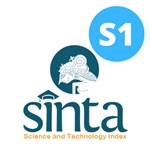Model of Maternal and Child Health (MCH) Surveillance System on Women Workers to Save the First 1000 Days of Life
Downloads
Introduction: There are risk of physical, chemical, biological, ergonomic, and psychosocial hazards in workplace which may pose harm to women and their fetuses, especially if it is related to chemical hazards. Chemicals and radiation at workplace may increase the incidence of congenital anomalies, infant morbidity and mortality as well as recurrent abortion. The purpose of this study was to compile MCH surveillance. Method: A qualitative study design was used and a case study was conducted on three manufacturing companies in Sidoarjo District from August to October 2017. Thirty respondents from each company were selected using accidental sampling. Socio demographic and job-related data were obtained from the respondents. The variables of this research were personnel that were given training about public health center, data types, data instruments, data collection, data processing, data analysis, information dissemination, and comprehensive MCH information. Result: The MCH surveillance system for women workers in order to save the first 1000 days of life consisted of inputs, processes, and outputs. Inputs included worker factors, company factors, surveillance staff factors, data types and data instruments. The surveillance process consisted of several processes including data collection, data processing, data analysis, and information dissemination. Output in this service model was comprehensive maternal and child health information that can be applied in company. Conclusion: MCH surveillance model consists of input, process, and output. Every industry has unique characteristic which is not found in other type of industry.
Keywords: child, health, maternal, surveillance
Ayu, A. (2016) Baru 53,1 Persen Bayi Dapat ASI Ekslusif, Surabaya: Jawa Pos.
District Health Office of Sidoarjo (2016) Laporan Kinerja. Sidoarjo: District Health Office of Sidoarjo.
International Labour Organization (2013) Keselamatan dan Kesehatan Kerja : Sarana untuk Produktivitas. 5th edn. Jakarta: International Labour Organization.
Kusuma, N. and Raharjo, S. T. (2016) ‘Penanganan Masalah Pekerja Anak melalui Pemberdayaan Organisasi Lokal "Forum Peduli Anak” di Kelurahan Cibeureum Kota Cimahi', Share : Social Work Journal, 6(1), pp. 9–29.
Minarto et al. (2018) Penguatan Koordinasi Pembangunan Pangan dan Gizi dalam Penurunan Stunting. Jakarta: Ministry of National Development Planning of the Republic of Indonesia.
Minister of Health of the Republic of Indonesia (2003) Nomor 1116/Menkes/SK/VIII/2003 tentang Pedoman Pelaksanaan Sistem Pengawasan Epidemiologi Kesehatan. Jakarta: Minister of Health of the Republic of Indonesia.
Minister of Health of the Republic of Indonesia (2010) Laporan Nasional Riset Dasar Kesehatan 2010. Jakarta: Ministry of Health of the Republik of Indonesia.
Minister of Health of the Republic of Indonesia (2014) Nomor 45 tahun 2014 tentang Penyelenggaraan Surveilans Kesehatan. Jakarta: Minister of Health of the Republic of Indonesia.
Muhammad, C. I., Santoso, M. B. and Zainudin, M. (2017) ‘Penetapan Struktur Organisiasi dan Tata Kerja pada Organisasi Pelayanan Sosial Rumah Cemara Kota Bandung', in Prosiding Penelitian dan Pengabdian kepada Masyarakat, pp. 390–447.
Rahmawati, W. et al. (2016) ‘Gambaran Masalah Gizi pada 1000 HPK di Kota dan Kabupaten Malang, Indonesia', Indonesian Journal of Human Nutrition, 3(1), pp. 20–31.
Septiani, H., Budi, A. and Karbito (2017) ‘Faktor-Faktor yang Berhubungan dengan Pemberian ASI Eksklusif Oleh Ibu Menyusui yang Bekerja Sebagai Tenaga Kesehatan', Aisyah: Jurnal Ilmu Kesehatan, 2(2), pp. 159 – 174.
Wendiranti, C. I., Subagio, H. W. and Wijayanti, H. S. (2017) ‘Faktor Risiko Kegagalan ASI Eksklusif', Journal of Nutrition College, 6(3), pp. 241–248.

In order to be accepted and published by The Indonesian Journal of Occupational Safety and Health, Author(s) who submit an article should complete all the review process. The copyright of received articles assigned to the The Indonesian Journal of Occupational Safety and Health and Department of Safety and Health, Universitas Airlangga as publishers of the journal. The intended copyright includes the rights to publish articles in various forms (including reprints).
The Editorial Team of The Indonesian Journal Of Occupational Safety and Health and Department of Safety and Health strive to ensure that no errors occur in the articles that have been published, both data errors and statements in the article.
Users of this website will be licensed to use materials from this website following the Creative Commons Attribution-NonCommercial-ShareAlike 4.0 International License. No fees charged. Please use the materials accordingly.
------------------------------------------------------------------------------------------------------------------------------------------------------------------------------------------
Attribution ” You must give appropriate credit, provide a link to the license, and indicate if changes were made. You may do so in any reasonable manner, but not in any way that suggests the licensor endorses you or your use.
NonCommercial ” You may not use the material for commercial purposes.
ShareAlike ” If you remix, transform, or build upon the material, you must distribute your contributions under the same license as the original.







 How to Submit Articles in OJS
How to Submit Articles in OJS

























